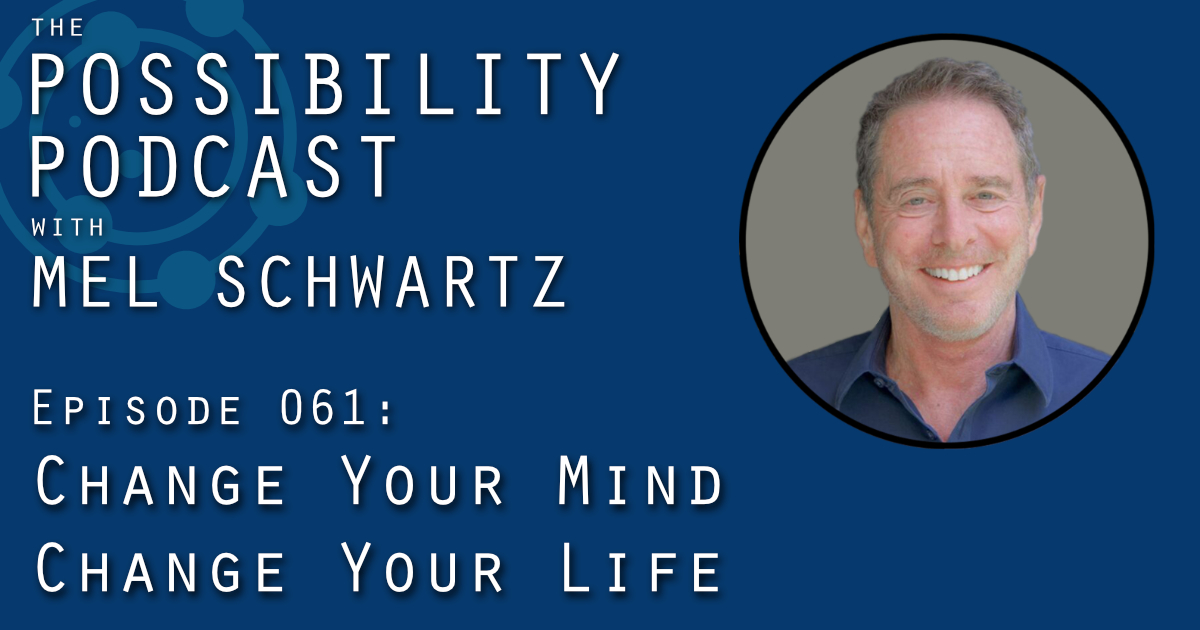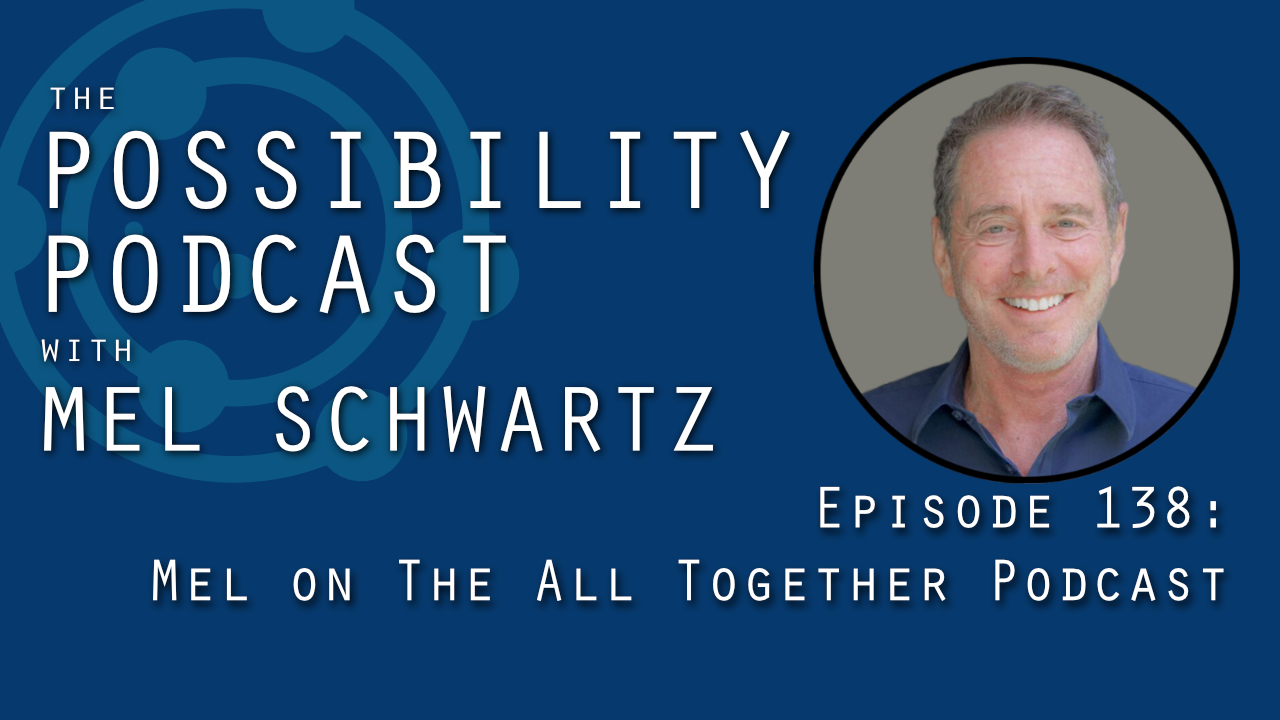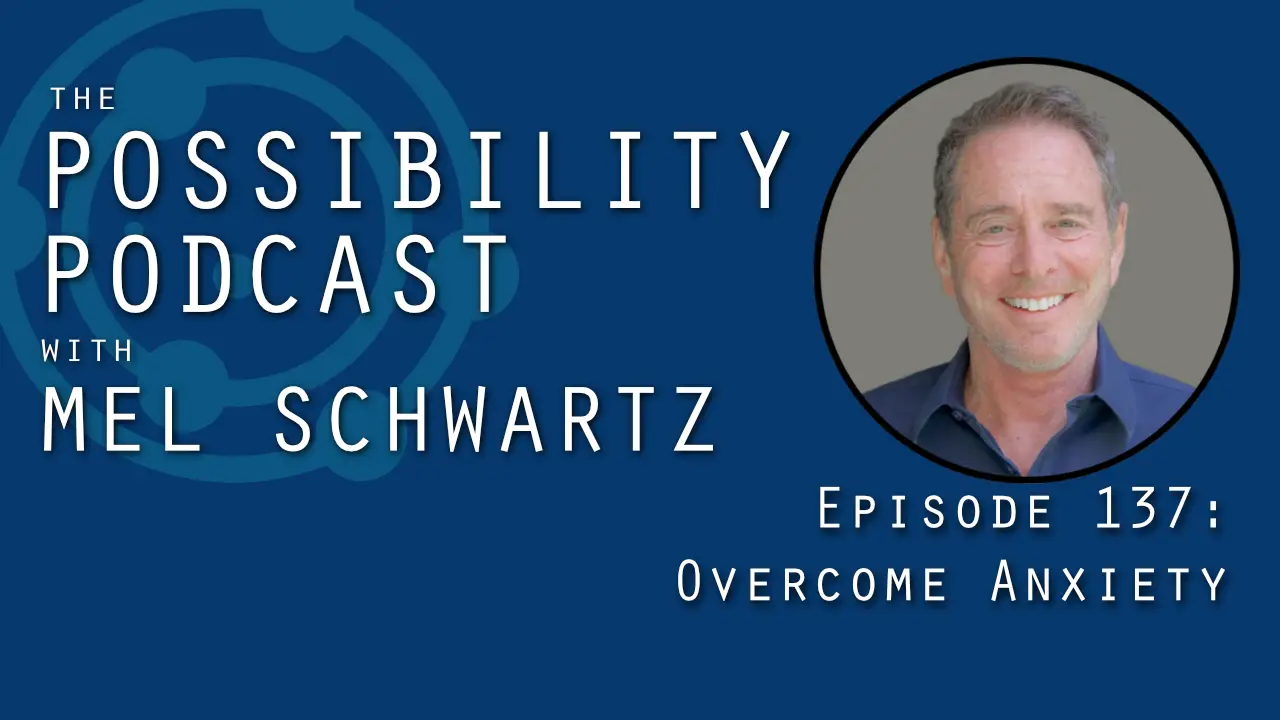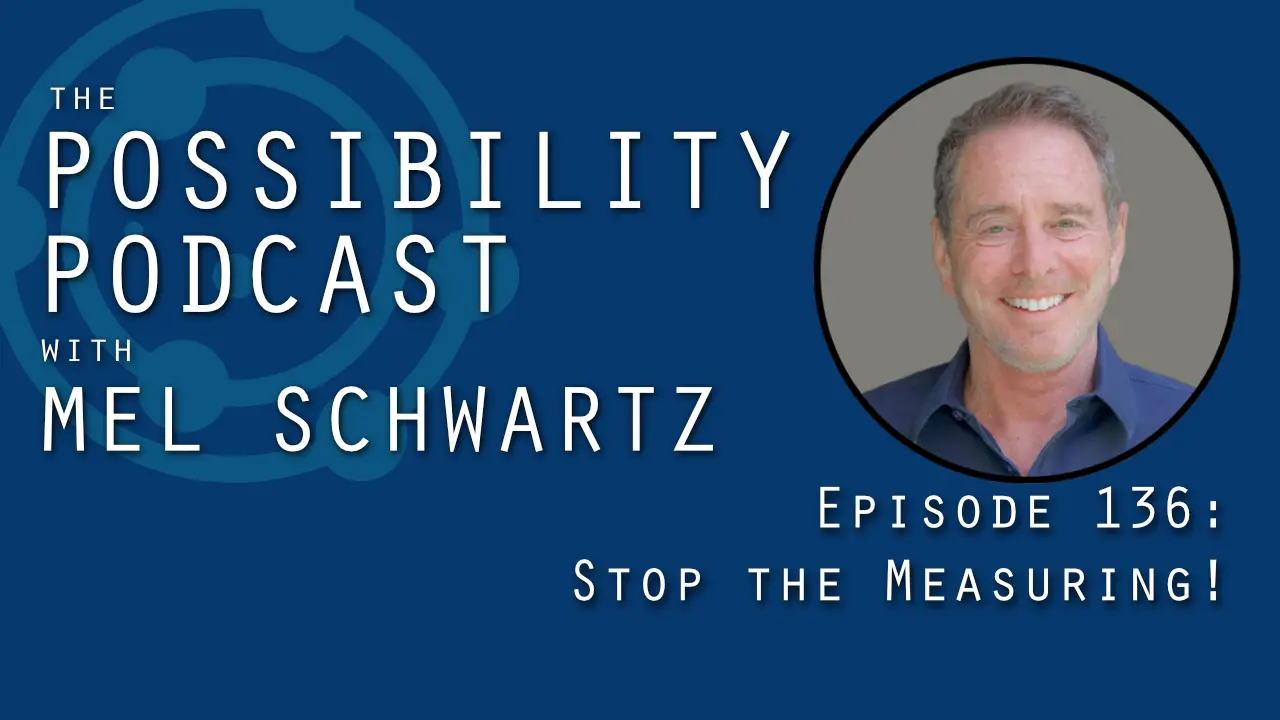Podcast: Play in new window | Download
Subscribe: RSS
In episode 061 of the Possibility Podcast with Mel Schwartz, our host explains how we can change our lives if we can change our mind: if we can jettison old thinking to embrace the potential of positive disruption.
What does this mean?
Interested in bespoke marriage and relationship counseling from Mel Schwartz? Reach out!
Listen as Mel explains…
- how beliefs are self-fulfilling prophesies
- why change is only hard if we approach it with fear
- how comfort (even in unhappiness) keeps us safe in the “familiar zone”
- why change requires disruption
- how disruption need not have a negative connotation
- how exploring our thoughts can reveal stagnant patterns
- why adjusting our perception of change leads to adventure and growth
Have you embraced uncertainty and disruption in order to experience growth and change in your life? Be sure to leave a comment!
Want to watch this episode?
Transcript of The Possibility Podcast with Mel Schwartz #061
Welcome to today’s episode. Today, we’re going to be exploring the nature of change, or at least we’re going to take a shallow dive into this very complex topic and probably follow it up in future episodes.
There’s a commonly held belief: It’s hard to change.
You know beliefs are self-fulfill prophecies. I can go into so many aspects of why we find change hard, but today we’re going to take a look at some of the more accessible reasons as to why.
If we live our lives based upon fear of making a mistake, if we live our lives based upon conforming to what we think our right behavior is, worried about what other people will think of us and our decisions… if we play it safe, then change is hard, isn’t it?
Yet we all have some aspect, or at least one aspect, of our lives that we’d like to change. It may be things external to us. But fundamentally, most change that we desire is in our relationship with our own self. So here’s what happens: we get stuck in what we call the familiar zone (or I call it the familiar zone — you may call it the comfort zone. For longtime listeners, you’ve heard me speak about the familiar zone many, many times).
Now there may be change that we desire, but that change lies outside of our familiar zone. Well, how do we access it? How do we change our mind and change our life? Change requires disruption.
Now, let’s look at the word disruption. It’s a notion that we usually find to be negative: “I don’t want to disrupt this or that, don’t disrupt me.”
There’s a negative connotation to disruption, but growth, creativity, insights, wisdom, brilliance, and change all require disruption.
Disruption from what?
Disruption from what is familiar. Now: to embrace that disruption and come out of our familiar zone, we need to embrace uncertainty and confusion. We have to be okay not knowing where we’re going to go.
Meaning: where our next sentence will go how, our next feelings will play out, how the other person may respond to what I say or do. Disruption, if it remains a bad word, is going to contain the change process. So, think about that for a moment: you can’t change if you want to avoid disruption.
That’s a dilemma, isn’t it?
Now: we can avoid change and struggle and stagnate. Or we can embrace change, which means we have to invite in disruption. If you’re not feeling fulfilled or happy about some aspect of your life, why wouldn’t you welcome some disruption? Disruption could be good in that circumstance, couldn’t it? If we embrace confusion, embrace uncertainty, embrace not knowing, and make them our ally, then on a macro level, on the big picture level, change wouldn’t be hard.
The fundamental thing that holds us back from the change process, tend to be our beliefs. I’m speaking now more personally, more privately.
Now look at these beliefs that you have about yourself that limit you or constrain you or induce fear, and ask yourself: how did I come to that belief? How do I know it’s true?
We as a people don’t employ critical thinking in terms of our own lives. We were taught in school to become critical thinkers, to analyze and look at what’s out there in our lives, so we could access it and value it and make decisions about things external to us: critical thinking. But do we employ critical thinking in our lives? The months turn into years and the years turn into decades and we struggle. We want for more; better. We may be serenity, contentment, love, success… but we want for something that we’re feeling frustrated about. We must employ critical thinking at that moment to ignite the change process. The critical thinking starts with looking at our beliefs; our limiting beliefs, and asking, “How did I come to that belief?”
Our beliefs become self-fulfilling prophecies and “change is hard” is a self-fulfilling prophecy.
Now, I know that people experience moments or events which don’t line up with their beliefs in a positive way. What I mean is, if you have a belief that you’re not lovable, but any number of people act and treat you lovingly, and even tell you that they love you, and they are believable and credible, do you welcome in the dissonance? The dissonance between I’m not lovable, but they told me I’m lovable… or do you discard the dissonance?
You see, when we discard something that’s dissonant, something that does not fit into our belief system, when we marginalize it or discard it? We stall out. There’s no change.. There’s no insight.
Science works on inviting in dissonant evidence; new evidence. But as human beings do we open to new evidence? Do we open to dissonance and embrace it, or we discard it?
So we need that dissonance, we need to turn this tension of what if into an adventure.
“What if I could do this? What if I could be happier? What if I could thrive in my life? What do I need to do?”
Employ critical thinking. Look at my beliefs and my thoughts of the holding me back. Invite in the dissonance. Invite in the critical thinking.
Now: what gets in the way of doing this?
What gets in the way is our lives start to look like a conveyor belt. We shun and disregard dissonance. We avoid disruption. We don’t critically think about ourselves.
We have to invite in curiosity. Instead of saying, “I am such and such and so and so,” in a fixed, rigid way, we need to embrace curiosity. We need to say to ourselves, “what if?” Not in a fearful way, not in the way we’re afraid of making a mistake, but “what if” in terms of the critical thinking to open us up, to release us from the straitjacket that makes us conform day in and day out to the same thoughts and the same feelings, so the repetition continues ad nauseum.
Change does not need to be hard as long as we are able to invite in and embrace disruption: coming out of our familiar zone.
More particularly: watch your thoughts that defend their territory.
When I am working with a client and they make a breakthrough and insight that can turn their life in a strong positive new direction, there’s a moment that I’m waiting for.
In that moment when the insight has been achieved, when all the confusion breaks apart and they can see the way forward, they might either say, “I know I’m not going to do this,” or they might say, “It’s going to be so hard,” or, “What took me so long?” Or they might say, “This is so exciting; I can’t wait.”
What is the litmus test for whether you move forward with change or you stay stuck in the old Familiar Zone? What informs that difference are your thoughts. When you have a thought that tells you you can’t do it, that is old thought defending its territory.
So on the granular level: What gets in the way of your change process? Old thought.
In my book The Possibility Principle, I go into great detail explaining how old thought defends its territory.
I was working recently with a middle-aged man on the topic around something he felt stuck with. He had felt stuck with it for a long time — his whole lifetime — It was holding him back.
We drilled down. He came to understand his limiting belief about himself. There was an opportunity the following day for him to actually disrupt his limitations and move forward. The road was clear. He accepted the insight; he lightened up; he felt hopeful… and then in the next moment he said, “I don’t think I’m going to be able to do it. It seems too hard.”
What was that? That was old thought defending its territory, corralling him back in and saying to him, “You’re not going anywhere.”
Old thought has a life of its own. The change process need not be hard when you learn to see the old thought that’s limiting you and replace it with new thinking.
So, new thinking is, “I’m having a thought. It’s an old thought and it’s telling me I can’t do that or I’m feeling fearful about doing it.” New thinking: “I’m going to do it anyway. I’m going to step out of my familiar zone and I’m going to invite in a new experience. I owe it to myself.”
It all comes down to saying to yourself, “Why I can’t,” or, “Why can’t I?”
If you choose “Why can’t I,” then change is not hard. But if you’re going to choose “Why can’t I,” you have to invite in dissonance. You have to welcome disruption: disruptive thinking, disruptive insights, disruptive feelings… need not be negative. They will break you out of the familiar zone, but you have to welcome and embrace the confusion and the uncertainty, and then change becomes your ally.
In fact, it’s no longer even change. It becomes normal. It becomes a normal part of your process. Open to insights, to new contemplations; think that the familiar zone can be comfortable or uncomfortable, but it’s predictable. If I want change to be a part of my life; if I want to harness this incredible energy of change which makes life meaningful and purposeful, so I’m not acting from a script like a character in the script, the plot already written.
Change your mind, change your life.
Now I’ve just touched on the surface of this topic today. There’s so much more to dig into. Check out my book The Possibility Principle, which will move very deeply into this complex subject and hopefully make it simple and achievable. Until next time: ride the waves of change, embrace uncertainty, and disruption. Enjoy that ride, and I look forward to talking with you again soon.
Subscribe To the Possibility Podcast with Mel Schwartz
Don’t miss a single Possibility Podcast with Mel Schwartz! Subscribe for free in iTunes / Apple Podcasts, Spotify, RadioPublic, Spreaker, or wherever you listen to podcasts. Or, simply copy / paste the RSS link directly into the podcast app of your choice!
Please Rate and Review
If you enjoy The Possibility Podcast with Mel Schwartz, please take a moment to rate and review the show in iTunes / Apple Podcasts or Podchaser. It only takes a few minutes, and adding your review is as easy as clicking this link.
Your rating and review helps raise the visibility of The Possibility Podcast with Mel Schwartz, especially on iTunes / Apple Podcasts, which is one of the biggest podcasting platforms today. More visibility for the show means more listeners… and that growth means the show reaches — and helps — more people like you.
Thank you!
Talk With Mel!
Help others when Mel helps you: Contact Mel and find out how you can be a caller on the show and ask Mel a question. He’ll put the Possibility Principle to work for you, and your conversation will be recorded for use in a future episode of the podcast so other listeners can benefit.




